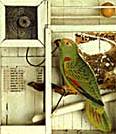www.faunaimportuk.com/caresheets/cswindspider.htm Fauna Import UK Care Sheet: WIND SPIDER (Galeodes arabs (Origin: Sinai desert) Also known as Camel spider, Wind scorpions, Solifugid.
www.snopes.com/photos/bugs/camelspider.asp (Urban Legends Site)
Bugs: Camel Spider
Does a photograph show camel spiders found in Iraq?
Camel spiders, also known as wind spiders, wind scorpions, and sun scorpions, are a type of arthropod found (among other places) in the deserts of the Middle East. They're technically not spiders but solifugae (although, like spiders, they belong to the class Arachnida). Camel spiders are the subject of a variety of legendary claims, many of them familiar to Americans because they were spread by U.S. servicemen who served in the Persian Gulf War in 1991, and re-spread at the beginning of the Iraq War in 2003:
* Camel spiders can grow to be as large as dinner plates.
* Camel spiders can traverse desert sand at speeds up to 25 MPH, making screaming noises as they run.
* Camel spiders can jump several feet in the air.
* Camel spiders eat the stomachs of camels, hence the name "camel spider." (Legend includes the detail that camel spiders eat camel stomachs from either the outside in or the inside out. In the former case they supposedly jump up from the ground and grab onto camels' bellies from underneath; in the latter case exactly how spiders allegedly as large as dinner plates get into camels' stomachs intact remains unexplained.)
* Camel spiders are venomous, and their venom contains a powerful anesthetic that numbs their victims (thus allowing them to gnaw away at living, immobilized animals without being noticed). U.S. soldiers were said to have been attacked by camel spiders at night but remained completely unaware of their plight until they awakened in the morning to find chunks of their flesh missing.
According to most spider experts, these claims are all false. Camel spiders (so named because, like camels, they can be found in sandy desert regions) grow to be moderately large (about a 5" leg span), but nowhere near as large as dinner plates; they can move very quickly in comparison to other arthropods (a top speed of maybe 10 MPH), but nothing close 25 MPH; they make no noise; and they capture prey without the use of either venom or anesthetic. Camel spiders rely on speed, stealth, and the (non-venomous) bite of powerful jaws to feed on small prey such as other arthropods (e.g., scorpions, crickets, pillbugs), lizards, and possibly mice or birds. They use only three pairs of legs in running; the frontmost pair (called pedipalpa) is held aloft and used in a similar manner to the antennae of insects. Camel spiders shun the sun and generally hide during the day, coming out at night to do their hunting.
Low, dishonest decade
5 years ago






No comments:
Post a Comment